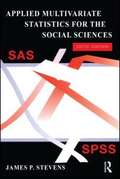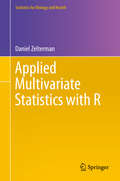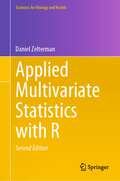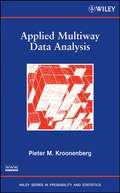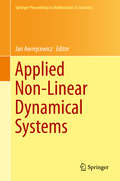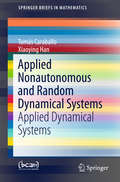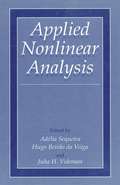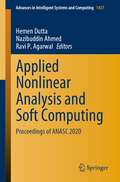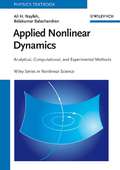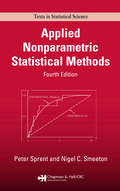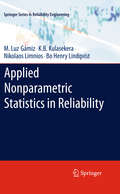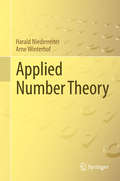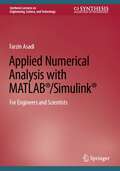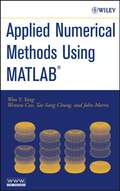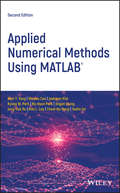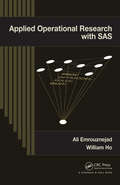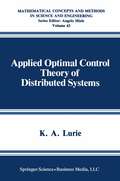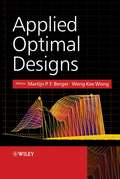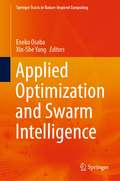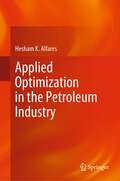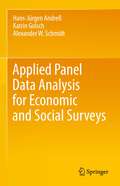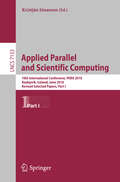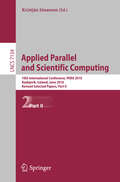- Table View
- List View
Applied Multivariate Statistics for the Social Sciences (5th edition)
by James P. StevensThis best-selling text is written for those who use, rather than develop statistical methods. Dr. Stevens focuses on a conceptual understanding of the material rather than on proving results. Helpful narrative and numerous examples enhance understanding and a chapter on matrix algebra serves as a review. Annotated printouts from SPSS and SAS indicate what the numbers mean and encourage interpretation of the results. In addition to demonstrating how to use these packages, the author stresses the importance of checking the data, assessing the assumptions, and ensuring adequate sample size by providing guidelines so that the results can be generalized. The book is noted for its extensive applied coverage of MANOVA, its emphasis on statistical power, and numerous exercises including answers to half. The new edition features: New chapters on Hierarchical Linear Modeling (Ch. 15) and Structural Equation Modeling (Ch. 16) New exercises that feature recent journal articles to demonstrate the actual use of multiple regression (Ch. 3), MANOVA (Ch. 5), and repeated measures (Ch. 13) A new appendix on the analysis of correlated observations (Ch. 6) Expanded discussions on obtaining non-orthogonal contrasts in repeated measures designs with SPSS and how to make the identification of cell ID easier in log linear analysis in 4 or 5 way designs Updated versions of SPSS (15. 0) and SAS (8. 0) are used throughout the text and introduced in chapter 1 A book website with data sets and more. Ideal for courses on multivariate statistics found in psychology, education, sociology, and business departments, the book also appeals to practising researchers with little or no training in multivariate methods. Prerequisites include a course on factorial ANOVA and covariance. Working knowledge of matrix algebra is not assumed.
Applied Multivariate Statistics for the Social Sciences (5th edition) (PDF)
by James P. StevensThis best-selling text is written for those who use, rather than develop statistical methods. Dr. Stevens focuses on a conceptual understanding of the material rather than on proving results. Helpful narrative and numerous examples enhance understanding and a chapter on matrix algebra serves as a review. Annotated printouts from SPSS and SAS indicate what the numbers mean and encourage interpretation of the results. In addition to demonstrating how to use these packages, the author stresses the importance of checking the data, assessing the assumptions, and ensuring adequate sample size by providing guidelines so that the results can be generalized. The book is noted for its extensive applied coverage of MANOVA, its emphasis on statistical power, and numerous exercises including answers to half. The new edition features: New chapters on Hierarchical Linear Modeling (Ch. 15) and Structural Equation Modeling (Ch. 16) New exercises that feature recent journal articles to demonstrate the actual use of multiple regression (Ch. 3), MANOVA (Ch. 5), and repeated measures (Ch. 13) A new appendix on the analysis of correlated observations (Ch. 6) Expanded discussions on obtaining non-orthogonal contrasts in repeated measures designs with SPSS and how to make the identification of cell ID easier in log linear analysis in 4 or 5 way designs Updated versions of SPSS (15. 0) and SAS (8. 0) are used throughout the text and introduced in chapter 1 A book website with data sets and more. Ideal for courses on multivariate statistics found in psychology, education, sociology, and business departments, the book also appeals to practicing researchers with little or no training in multivariate methods. Prerequisites include a course on factorial ANOVA and covariance. Working knowledge of matrix algebra is not assumed.
Applied Multivariate Statistics with R (Statistics for Biology and Health)
by Daniel ZeltermanThis book brings the power of multivariate statistics to graduate-level practitioners, making these analytical methods accessible without lengthy mathematical derivations. Using the open source, shareware program R, Professor Zelterman demonstrates the process and outcomes for a wide array of multivariate statistical applications. Chapters cover graphical displays, linear algebra, univariate, bivariate and multivariate normal distributions, factor methods, linear regression, discrimination and classification, clustering, time series models, and additional methods. Zelterman uses practical examples from diverse disciplines to welcome readers from a variety of academic specialties. Those with backgrounds in statistics will learn new methods while they review more familiar topics. Chapters include exercises, real data sets, and R implementations. The data are interesting, real-world topics, particularly from health and biology-related contexts. As an example of the approach, the text examines a sample from the Behavior Risk Factor Surveillance System, discussing both the shortcomings of the data as well as useful analyses. The text avoids theoretical derivations beyond those needed to fully appreciate the methods. Prior experience with R is not necessary.
Applied Multivariate Statistics with R (Statistics for Biology and Health)
by Daniel ZeltermanNow in its second edition, this book brings multivariate statistics to graduate-level practitioners, making these analytical methods accessible without lengthy mathematical derivations. Using the open source shareware program R, Dr. Zelterman demonstrates the process and outcomes for a wide array of multivariate statistical applications. Chapters cover graphical displays; linear algebra; univariate, bivariate and multivariate normal distributions; factor methods; linear regression; discrimination and classification; clustering; time series models; and additional methods. He uses practical examples from diverse disciplines, to welcome readers from a variety of academic specialties. Each chapter includes exercises, real data sets, and R implementations. The book avoids theoretical derivations beyond those needed to fully appreciate the methods. Prior experience with R is not necessary.New to this edition are chapters devoted to longitudinal studies and the clustering of large data. It is an excellent resource for students of multivariate statistics, as well as practitioners in the health and life sciences who are looking to integrate statistics into their work.
Applied Multiway Data Analysis (Wiley Series in Probability and Statistics #702)
by Pieter M. KroonenbergFrom a preeminent authority—a modern and applied treatment of multiway data analysis This groundbreaking book is the first of its kind to present methods for analyzing multiway data by applying multiway component techniques. Multiway analysis is a specialized branch of the larger field of multivariate statistics that extends the standard methods for two-way data, such as component analysis, factor analysis, cluster analysis, correspondence analysis, and multidimensional scaling to multiway data. Applied Multiway Data Analysis presents a unique, thorough, and authoritative treatment of this relatively new and emerging approach to data analysis that is applicable across a range of fields, from the social and behavioral sciences to agriculture, environmental sciences, and chemistry. General introductions to multiway data types, methods, and estimation procedures are provided in addition to detailed explanations and advice for readers who would like to learn more about applying multiway methods. Using carefully laid out examples and engaging applications, the book begins with an introductory chapter that serves as a general overview of multiway analysis, including the types of problems it can address. Next, the process of setting up, carrying out, and evaluating multiway analyses is discussed along with commonly encountered issues, such as preprocessing, missing data, model and dimensionality selection, postprocessing, and transformation, as well as robustness and stability issues. Extensive examples are presented within a unified framework consisting of a five-step structure: objectives; data description and design; model and dimensionality selection; results and their interpretation; and validation. Procedures featured in the book are conducted using 3WayPack, which is software developed by the author, and analyses can also be carried out within the R and MATLAB systems. Several data sets and 3WayPack can be downloaded via the book's related Web site. The author presents the material in a clear, accessible style without unnecessary or complex formalism, assuring a smooth transition from well-known standard two-analysis to multiway analysis for readers from a wide range of backgrounds. An understanding of linear algebra, statistics, and principal component analyses and related techniques is assumed, though the author makes an effort to keep the presentation at a conceptual, rather than mathematical, level wherever possible. Applied Multiway Data Analysis is an excellent supplement for component analysis and statistical multivariate analysis courses at the upper-undergraduate and beginning graduate levels. The book can also serve as a primary reference for statisticians, data analysts, methodologists, applied mathematicians, and social science researchers working in academia or industry. Visit the Related Website: http://three-mode.leidenuniv.nl/, to view data from the book.
Applied Non-Linear Dynamical Systems (Springer Proceedings in Mathematics & Statistics #93)
by Jan AwrejcewiczThe book is a collection of contributions devoted to analytical, numerical and experimental techniques of dynamical systems, presented at the International Conference on Dynamical Systems: Theory and Applications, held in Łódź, Poland on December 2-5, 2013. The studies give deep insight into both the theory and applications of non-linear dynamical systems, emphasizing directions for future research. Topics covered include: constrained motion of mechanical systems and tracking control; diversities in the inverse dynamics; singularly perturbed ODEs with periodic coefficients; asymptotic solutions to the problem of vortex structure around a cylinder; investigation of the regular and chaotic dynamics; rare phenomena and chaos in power converters; non-holonomic constraints in wheeled robots; exotic bifurcations in non-smooth systems; micro-chaos; energy exchange of coupled oscillators; HIV dynamics; homogenous transformations with applications to off-shore slender structures; novel approaches to a qualitative study of a dissipative system; chaos of postural sway in humans; oscillators with fractional derivatives; controlling chaos via bifurcation diagrams; theories relating to optical choppers with rotating wheels; dynamics in expert systems; shooting methods for non-standard boundary value problems; automatic sleep scoring governed by delay differential equations; isochronous oscillations; the aerodynamics pendulum and its limit cycles; constrained N-body problems; nano-fractal oscillators and dynamically-coupled dry friction.
Applied Nonautonomous and Random Dynamical Systems: Applied Dynamical Systems (SpringerBriefs in Mathematics)
by Tomás Caraballo Xiaoying HanThis book offers an introduction to the theory of non-autonomous and stochastic dynamical systems, with a focus on the importance of the theory in the Applied Sciences. It starts by discussing the basic concepts from the theory of autonomous dynamical systems, which are easier to understand and can be used as the motivation for the non-autonomous and stochastic situations. The book subsequently establishes a framework for non-autonomous dynamical systems, and in particular describes the various approaches currently available for analysing the long-term behaviour of non-autonomous problems. Here, the major focus is on the novel theory of pullback attractors, which is still under development. In turn, the third part represents the main body of the book, introducing the theory of random dynamical systems and random attractors and revealing how it may be a suitable candidate for handling realistic models with stochasticity. A discussion of future research directions serves to round out the coverage.
Applied Nonlinear Analysis
by Adélia Sequeira Hugo Beirão Da Veiga Juha H. VidemanThis book is meant as a present to honor Professor on the th occasion of his 70 birthday. It collects refereed contributions from sixty-one mathematicians from eleven countries. They cover many different areas of research related to the work of Professor including Navier-Stokes equations, nonlinear elasticity, non-Newtonian fluids, regularity of solutions of parabolic and elliptic problems, operator theory and numerical methods. The realization of this book could not have been made possible without the generous support of Centro de Matemática Aplicada (CMA/IST) and Fundação Calouste Gulbenkian. Special thanks are due to Dr. Ulrych for the careful preparation of the final version of this book. Last but not least, we wish to express our gratitude to Dr. for her invaluable assistance from the very beginning. This project could not have been successfully concluded without her enthusiasm and loving care for her father. On behalf of the editors ADÉLIA SEQUEIRA v honored by the Order of Merit of the Czech Republic by Václav Havel, President of the Czech Republic, on the October 28, 1998, Professor Emeritus of Mathematics at the Charles University in Prague, Presidential Research Professor at the Northern Illinois University and Doctor Honoris Causa at the Technical University of Dresden, has been enriching the Czech and world mathematics with his new ideas in the areas of partial differential equations, nonlinear functional analysis and applications of the both disciplines in continuum mechanics and hydrodynamics for more than forty years.
Applied Nonlinear Analysis and Soft Computing: Proceedings of ANASC 2020 (Advances in Intelligent Systems and Computing #1437)
by Hemen Dutta Nazibuddin Ahmed Ravi P. AgarwalThe volume contains original research papers as the Proceedings of the International Conference on Applied Nonlinear Analysis and Soft Computing (ANASC 2020), held at Gauhati University, Guwahati, India, on 22-23 December, 2020. It focuses on current research topics in applied analysis including nonlinearity, soft computing and related areas. It primarily includes topics related to pattern recognition, reaction-diffusion problem, decision making problems, inventory model, predator-prey model, logistic models, wave problems, problems in Magnetohydrodynamics, cosmological model, harmonic functions, graphs, shapes, etc. Researchers, educators, scientist and professionals interested in recent developments in applied analysis including nonlinearity aspects and soft computing should be benefited from this volume.
Applied Nonlinear Dynamics: Analytical, Computational, and Experimental Methods (Wiley Series in Nonlinear Science)
by Ali H. Nayfeh Balakumar BalachandranA unified and coherent treatment of analytical, computational and experimental techniques of nonlinear dynamics with numerous illustrative applications. Features a discourse on geometric concepts such as Poincare maps. Discusses chaos, stability and bifurcation analysis for systems of differential and algebraic equations. Includes scores of examples to facilitate understanding.
Applied Nonparametric Statistical Methods (Chapman And Hall/crc Texts In Statistical Science Ser.)
by Peter Sprent Nigel C. SmeetonWhile preserving the clear, accessible style of previous editions, Applied Nonparametric Statistical Methods, Fourth Edition reflects the latest developments in computer-intensive methods that deal with intractable analytical problems and unwieldy data sets. Reorganized and with additional material, this edition begins with a brief summary of some
Applied Nonparametric Statistics in Reliability (Springer Series in Reliability Engineering)
by M. Luz Gámiz K. B. Kulasekera Nikolaos Limnios Bo Henry LindqvistNonparametric statistics has probably become the leading methodology for researchers performing data analysis. It is nevertheless true that, whereas these methods have already proved highly effective in other applied areas of knowledge such as biostatistics or social sciences, nonparametric analyses in reliability currently form an interesting area of study that has not yet been fully explored. Applied Nonparametric Statistics in Reliability is focused on the use of modern statistical methods for the estimation of dependability measures of reliability systems that operate under different conditions. The scope of the book includes: smooth estimation of the reliability function and hazard rate of non-repairable systems; study of stochastic processes for modelling the time evolution of systems when imperfect repairs are performed; nonparametric analysis of discrete and continuous time semi-Markov processes; isotonic regression analysis of the structure function of a reliability system, and lifetime regression analysis. Besides the explanation of the mathematical background, several numerical computations or simulations are presented as illustrative examples. The corresponding computer-based methods have been implemented using R and MATLAB®. A concrete modelling scheme is chosen for each practical situation and, in consequence, a nonparametric inference procedure is conducted. Applied Nonparametric Statistics in Reliability will serve the practical needs of scientists (statisticians and engineers) working on applied reliability subjects.
Applied Number Theory
by Harald Niederreiter Arne WinterhofThis textbook effectively builds a bridge from basic number theory to recent advances in applied number theory. It presents the first unified account of the four major areas of application where number theory plays a fundamental role, namely cryptography, coding theory, quasi-Monte Carlo methods, and pseudorandom number generation, allowing the authors to delineate the manifold links and interrelations between these areas.Number theory, which Carl-Friedrich Gauss famously dubbed the queen of mathematics, has always been considered a very beautiful field of mathematics, producing lovely results and elegant proofs. While only very few real-life applications were known in the past, today number theory can be found in everyday life: in supermarket bar code scanners, in our cars’ GPS systems, in online banking, etc.Starting with a brief introductory course on number theory in Chapter 1, which makes the book more accessible for undergraduates, the authors describe the four main application areas in Chapters 2-5 and offer a glimpse of advanced results that are presented without proofs and require more advanced mathematical skills. In the last chapter they review several further applications of number theory, ranging from check-digit systems to quantum computation and the organization of raster-graphics memory.Upper-level undergraduates, graduates and researchers in the field of number theory will find this book to be a valuable resource.
Applied Numerical Analysis with MATLAB®/Simulink®: For Engineers and Scientists (Synthesis Lectures on Engineering, Science, and Technology)
by Farzin AsadiThis textbook provides a compact but comprehensive treatment that guides students through applied numerical analysis, using MATLAB®/Simulink®. Ideal as a hands-on source for courses in Numerical Analysis, this text focuses on solving problems using market-standard software, corresponding to all key concepts covered in the classroom. The author uses his extensive classroom experience to guide students toward deeper understanding of key concepts, while they gain facility with software they will need to master for later studies and practical use in their engineering careers.
Applied Numerical Methods Using MATLAB
by Won Y. Yang Wenwu Cao Tae-Sang Chung John MorrisIn recent years, with the introduction of new media products, there has been a shift in the use of programming languages from FORTRAN or C to MATLAB for implementing numerical methods. This book makes use of the powerful MATLAB software to avoid complex derivations, and to teach the fundamental concepts using the software to solve practical problems. Over the years, many textbooks have been written on the subject of numerical methods. Based on their course experience, the authors use a more practical approach and link every method to real engineering and/or science problems. The main benefit is that engineers don't have to know the mathematical theory in order to apply the numerical methods for solving their real-life problems. An Instructor's Manual presenting detailed solutions to all the problems in the book is available online.
Applied Numerical Methods Using MATLAB
by Won Y. Yang Wenwu Cao Jaekwon Kim Kyung W. Park Ho-Hyun Park Jingon Joung Jong-Suk Ro Han L. Lee Cheol-Ho Hong Taeho ImThis new edition provides an updated approach for students, engineers, and researchers to apply numerical methods for solving problems using MATLAB® This accessible book makes use of MATLAB® software to teach the fundamental concepts for applying numerical methods to solve practical engineering and/or science problems. It presents programs in a complete form so that readers can run them instantly with no programming skill, allowing them to focus on understanding the mathematical manipulation process and making interpretations of the results. Applied Numerical Methods Using MATLAB®, Second Edition begins with an introduction to MATLAB usage and computational errors, covering everything from input/output of data, to various kinds of computing errors, and on to parameter sharing and passing, and more. The system of linear equations is covered next, followed by a chapter on the interpolation by Lagrange polynomial. The next sections look at interpolation and curve fitting, nonlinear equations, numerical differentiation/integration, ordinary differential equations, and optimization. Numerous methods such as the Simpson, Euler, Heun, Runge-kutta, Golden Search, Nelder-Mead, and more are all covered in those chapters. The eighth chapter provides readers with matrices and Eigenvalues and Eigenvectors. The book finishes with a complete overview of differential equations. Provides examples and problems of solving electronic circuits and neural networks Includes new sections on adaptive filters, recursive least-squares estimation, Bairstow's method for a polynomial equation, and more Explains Mixed Integer Linear Programing (MILP) and DOA (Direction of Arrival) estimation with eigenvectors Aimed at students who do not like and/or do not have time to derive and prove mathematical results Applied Numerical Methods Using MATLAB®, Second Edition is an excellent text for students who wish to develop their problem-solving capability without being involved in details about the MATLAB codes. It will also be useful to those who want to delve deeper into understanding underlying algorithms and equations.
Applied Numerical Methods Using MATLAB
by Won Y. Yang Wenwu Cao Jaekwon Kim Kyung W. Park Ho-Hyun Park Jingon Joung Jong-Suk Ro Han L. Lee Cheol-Ho Hong Taeho ImThis new edition provides an updated approach for students, engineers, and researchers to apply numerical methods for solving problems using MATLAB® This accessible book makes use of MATLAB® software to teach the fundamental concepts for applying numerical methods to solve practical engineering and/or science problems. It presents programs in a complete form so that readers can run them instantly with no programming skill, allowing them to focus on understanding the mathematical manipulation process and making interpretations of the results. Applied Numerical Methods Using MATLAB®, Second Edition begins with an introduction to MATLAB usage and computational errors, covering everything from input/output of data, to various kinds of computing errors, and on to parameter sharing and passing, and more. The system of linear equations is covered next, followed by a chapter on the interpolation by Lagrange polynomial. The next sections look at interpolation and curve fitting, nonlinear equations, numerical differentiation/integration, ordinary differential equations, and optimization. Numerous methods such as the Simpson, Euler, Heun, Runge-kutta, Golden Search, Nelder-Mead, and more are all covered in those chapters. The eighth chapter provides readers with matrices and Eigenvalues and Eigenvectors. The book finishes with a complete overview of differential equations. Provides examples and problems of solving electronic circuits and neural networks Includes new sections on adaptive filters, recursive least-squares estimation, Bairstow's method for a polynomial equation, and more Explains Mixed Integer Linear Programing (MILP) and DOA (Direction of Arrival) estimation with eigenvectors Aimed at students who do not like and/or do not have time to derive and prove mathematical results Applied Numerical Methods Using MATLAB®, Second Edition is an excellent text for students who wish to develop their problem-solving capability without being involved in details about the MATLAB codes. It will also be useful to those who want to delve deeper into understanding underlying algorithms and equations.
Applied Operational Research with SAS
by Ali Emrouznejad William HoUsing a wide range of operational research (OR) optimization examples, Applied Operational Research with SAS demonstrates how the OR procedures in SAS work. The book is one of the first to extensively cover the application of SAS procedures to OR problems, such as single criterion optimization, project management decisions, printed circuit board as
Applied Optimal Control Theory of Distributed Systems (Mathematical Concepts and Methods in Science and Engineering #43)
by K.A. LurieThis book represents an extended and substantially revised version of my earlierbook, Optimal Control in Problems ofMathematical Physics,originally published in Russian in 1975. About 60% of the text has been completely revised and major additions have been included which have produced a practically new text. My aim was to modernize the presentation but also to preserve the original results, some of which are little known to a Western reader. The idea of composites, which is the core of the modern theory of optimization, was initiated in the early seventies. The reader will find here its implementation in the problem of optimal conductivity distribution in an MHD-generatorchannel flow.Sincethen it has emergedinto an extensive theory which is undergoing a continuous development. The book does not pretend to be a textbook, neither does it offer a systematic presentation of the theory. Rather, it reflects a concept which I consider as fundamental in the modern approach to optimization of dis tributed systems. Bibliographical notes,though extensive, do not pretend to be exhaustive as well. My thanks are due to ProfessorJean-Louis Armand and ProfessorWolf Stadler whose friendly assistance in translating and polishing the text was so valuable. I am indebted to Mrs. Kathleen Durand and Mrs. Colleen Lewis for the hard job of typing large portions of the manuscript.
Applied Optimal Designs
by Martijn P. F. Berger Weng Kee WongThere is an increasing need to rein in the cost of scientific study without sacrificing accuracy in statistical inference. Optimal design is the judicious allocation of resources to achieve the objectives of studies using minimal cost via careful statistical planning. Researchers and practitioners in various fields of applied science are now beginning to recognize the advantages and potential of optimal experimental design. Applied Optimal Designs is the first book to catalogue the application of optimal design to real problems, documenting its widespread use across disciplines as diverse as drug development, education and ground water modelling. Includes contributions covering: Bayesian design for measuring cerebral blood-flow Optimal designs for biological models Computer adaptive testing Ground water modelling Epidemiological studies and pharmacological models Applied Optimal Designs bridges the gap between theory and practice, drawing together a selection of incisive articles from reputed collaborators. Broad in scope and inter-disciplinary in appeal, this book highlights the variety of opportunities available through the use of optimal design. The wide range of applications presented here should appeal to statisticians working with optimal designs, and to practitioners new to the theory and concepts involved.
Applied Optimization and Swarm Intelligence (Springer Tracts in Nature-Inspired Computing)
by Eneko Osaba Xin-She YangThis book gravitates on the prominent theories and recent developments of swarm intelligence methods, and their application in both synthetic and real-world optimization problems. The special interest will be placed in those algorithmic variants where biological processes observed in nature have underpinned the core operators underlying their search mechanisms. In other words, the book centers its attention on swarm intelligence and nature-inspired methods for efficient optimization and problem solving. The content of this book unleashes a great opportunity for researchers, lecturers and practitioners interested in swarm intelligence, optimization problems and artificial intelligence.
Applied Optimization in the Petroleum Industry
by Hesham K. AlfaresThe book addresses optimization in the petroleum industry from a practical, large-scale-application-oriented point of view. The models and techniques presented help to optimize the limited resources in the industry in order to maximize economic benefits, ensure operational safety, and reduce environmental impact. The book discusses several important real-life applications of optimization in the petroleum industry, ranging from the scheduling of personnel time to the blending of gasoline. It covers a wide spectrum of relevant activities, including drilling, producing, maintenance, and distribution. The text begins with an introductory overview of the petroleum industry and then of optimization models and techniques. The main body of the book details a variety of applications of optimization models and techniques within the petroleum industry.Applied Optimization in the Petroleum Industry helps readers to find effective optimization-based solutions to their own practical problems in a large and important industrial sector, still the main source of the world’s energy and the source of raw materials for a wide variety of industrial and consumer products.
Applied Panel Data Analysis for Economic and Social Surveys
by Hans-Jürgen Andreß Katrin Golsch Alexander W. SchmidtMany economic and social surveys are designed as panel studies, which provide important data for describing social changes and testing causal relations between social phenomena. This textbook shows how to manage, describe, and model these kinds of data. It presents models for continuous and categorical dependent variables, focusing either on the level of these variables at different points in time or on their change over time. It covers fixed and random effects models, models for change scores and event history models. All statistical methods are explained in an application-centered style using research examples from scholarly journals, which can be replicated by the reader through data provided on the accompanying website. As all models are compared to each other, it provides valuable assistance with choosing the right model in applied research. The textbook is directed at master and doctoral students as well as applied researchers in the social sciences, psychology, business administration and economics. Readers should be familiar with linear regression and have a good understanding of ordinary least squares estimation.
Applied Parallel and Scientific Computing: 10th International Conference, PARA 2010, Reykjavík, Iceland, June 6-9, 2010, Revised Selected Papers, Part I (Lecture Notes in Computer Science #7133)
by Kristján JónassonThe two volume set LNCS 7133 and LNCS 7134 constitutes the thoroughly refereed post-conference proceedings of the 10th International Conference on Applied Parallel and Scientific Computing, PARA 2010, held in Reykjavík, Iceland, in June 2010. These volumes contain three keynote lectures, 29 revised papers and 45 minisymposia presentations arranged on the following topics: cloud computing, HPC algorithms, HPC programming tools, HPC in meteorology, parallel numerical algorithms, parallel computing in physics, scientific computing tools, HPC software engineering, simulations of atomic scale systems, tools and environments for accelerator based computational biomedicine, GPU computing, high performance computing interval methods, real-time access and processing of large data sets, linear algebra algorithms and software for multicore and hybrid architectures in honor of Fred Gustavson on his 75th birthday, memory and multicore issues in scientific computing - theory and praxis, multicore algorithms and implementations for application problems, fast PDE solvers and a posteriori error estimates, and scalable tools for high performance computing.
Applied Parallel and Scientific Computing: 10th International Conference, PARA 2010, Reykjavík, Iceland, June 6-9, 2010, Revised Selected Papers, Part II (Lecture Notes in Computer Science #7134)
by Kristján JónassonThe two volume set LNCS 7133 and LNCS 7134 constitutes the thoroughly refereed post-conference proceedings of the 10th International Conference on Applied Parallel and Scientific Computing, PARA 2010, held in Reykjavík, Iceland, in June 2010. These volumes contain three keynote lectures, 29 revised papers and 45 minisymposia presentations arranged on the following topics: cloud computing, HPC algorithms, HPC programming tools, HPC in meteorology, parallel numerical algorithms, parallel computing in physics, scientific computing tools, HPC software engineering, simulations of atomic scale systems, tools and environments for accelerator based computational biomedicine, GPU computing, high performance computing interval methods, real-time access and processing of large data sets, linear algebra algorithms and software for multicore and hybrid architectures in honor of Fred Gustavson on his 75th birthday, memory and multicore issues in scientific computing - theory and praxis, multicore algorithms and implementations for application problems, fast PDE solvers and a posteriori error estimates, and scalable tools for high performance computing.
